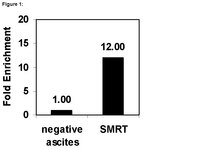Nuclear corepressors mediate the repression of phospholipase A2 group IIa gene transcription by thyroid hormone.
Sharma, P; Thakran, S; Deng, X; Elam, MB; Park, EA
The Journal of biological chemistry
288
16321-33
2013
Show Abstract
Secretory phospholipase A2 group IIa (PLA2g2a) is associated with inflammation, hyperlipidemia, and atherogenesis. Transcription of the PLA2g2a gene is induced by multiple cytokines. Here, we report the surprising observation that thyroid hormone (T3) inhibited PLA2g2a gene expression in human and rat hepatocytes as well as in rat liver. Moreover, T3 reduced the cytokine-mediated induction of PLA2g2a, suggesting that the thyroid status may modulate aspects of the inflammatory response. In an effort to dissect the mechanism of repression by T3, we cloned the PLA2g2a gene and identified a negative T3 response element in the promoter. This T3 receptor (TRβ)-binding site differed considerably from consensus T3 stimulatory elements. Using in vitro and in vivo binding assays, we found that TRβ bound directly to the PLA2g2a promoter as a heterodimer with the retinoid X receptor. Knockdown of nuclear corepressor or silencing mediator for retinoid and thyroid receptors by siRNA blocked the T3 inhibition of PLA2g2a. Using chromatin immunoprecipitation assays, we showed that nuclear corepressor and silencing mediator for retinoid and thyroid receptors were associated with the PLA2g2a gene in the presence of T3. In contrast with the established role of T3 to promote coactivator association with TRβ, our experiments demonstrate a novel inverse recruitment mechanism in which liganded TRβ recruits corepressors to inhibit PLA2g2a expression. | Western Blotting | 23629656
 |
Knockdown of menin affects pre-mRNA processing and promoter fidelity at the interferon-gamma inducible IRF1 gene.
Auriemma, LB; Shah, S; Linden, LM; Henriksen, MA
Epigenetics & chromatin
5
2
2012
Show Abstract
The tumor suppressor menin (MEN1) is mutated in the inherited disease multiple endocrine neoplasia type I, and has several documented cellular roles, including the activation and repression of transcription effected by several transcription factors. As an activator, MEN1 is a component of the Set1-like mixed lineage leukemia (MLL) MLL1/MLL2 methyltransferase complex that methylates histone H3 lysine 4 (H3K4). MEN1 is localized to the signal transducer and activator of transcription 1 (STAT1)-dependent gene, interferon regulatory factor 1 (IRF1), and is further recruited when IRF1 transcription is triggered by interferon-γ signaling.RNAi-mediated knockdown of MEN1 alters the H3K4 dimethylation and H3 acetylation profiles, and the localization of histone deacetylase 3, at IRF1. While MEN1 knockdown does not impact the rate of transcription, IRF1 heteronuclear transcripts become enriched in MEN1-depleted cells. The processed mRNA and translated protein product are concomitantly reduced, and the antiviral state is attenuated. Additionally, the transcription start site at the IRF1 promoter is disrupted in the MEN1-depleted cells. The H3K4 demethylase, lysine specific demethylase 1, is also associated with IRF1, and its inhibition alters H3K4 methylation and disrupts the transcription start site as well.Taken together, the data indicate that MEN1 contributes to STAT1-activated gene expression in a novel manner that includes defining the transcription start site and RNA processing. | | 22240255
 |











